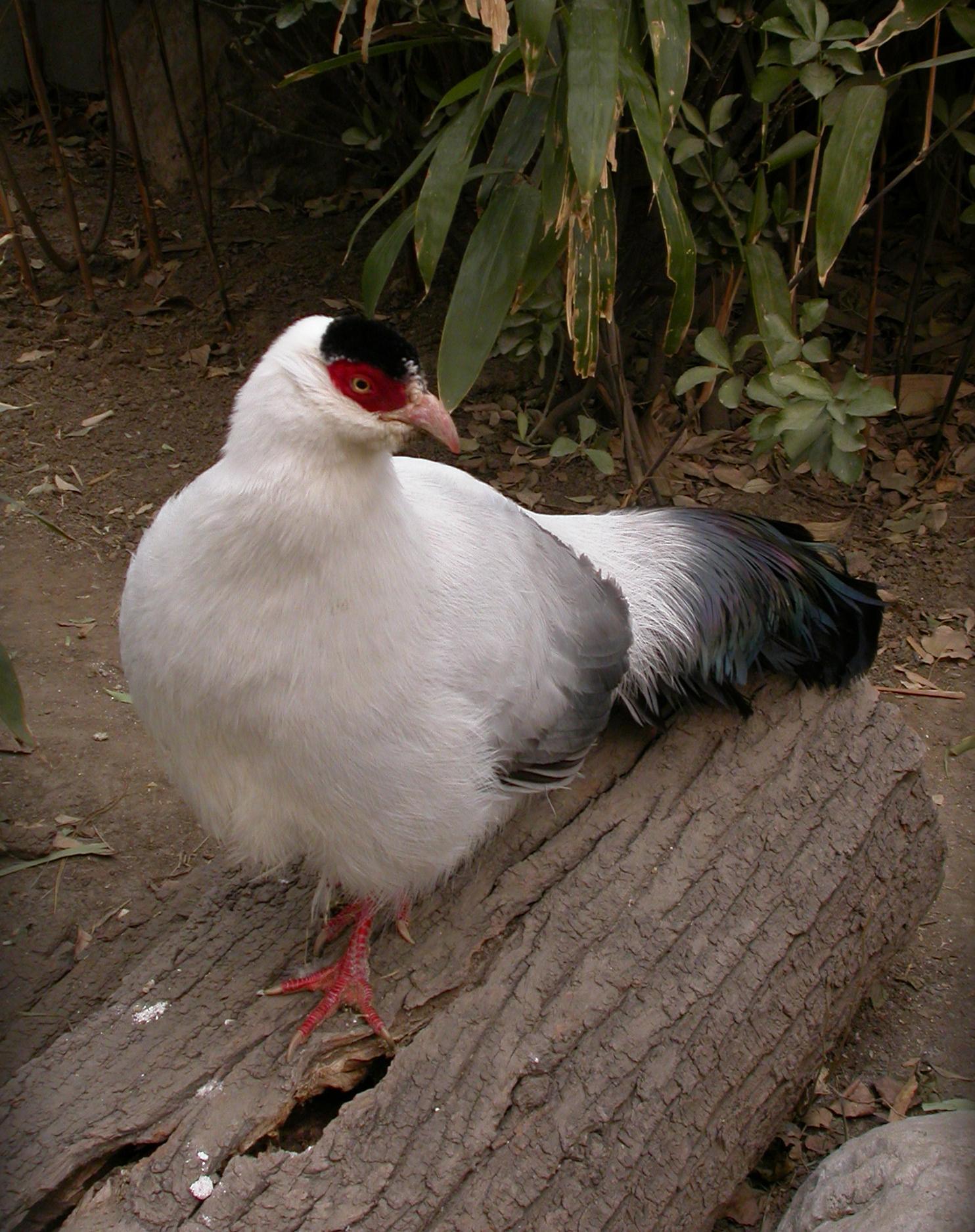- White-eared Pheasant
Taxobox
name = White eared Pheasant
status = NT | status_system = IUCN3.1

image_width = 200px
regnum =Animal ia
phylum = Chordata
classis = Aves
ordo =Galliformes
familia =Phasianidae
genus = "Crossoptilon "
species = "C. crossoptilon"
binomial = "Crossoptilon crossoptilon"
binomial_authority = (Hodgson, 1838)The Genus Crosssoptilon comprises four distinct ecological species of "Eared Pheasants", so named because of their prominent ear tufts.
White Eared Pheasants are called Shagga by indigenous Himalayan peoples. Shagga means Snow Fowl. Shagga are very gregarious birds, living in large flocks which forage on alpine meadow close to or above the snowline throughout the year. White Eared pheasants tend to fly a great deal more than their close relatives the brown eared and blue eared pheasants. All three ecological species are obliged to hover or volplane over deep snow. They do this with the aid of their great wide tails. Eared pheasants move across deep snow by whirring their wings and fluttering close to the ground, and supporting their weight on their retrices, leave characteristic if somewhat other worldly appearing tracks. Eared pheasant flight is often described as poor by the hunter collectors of the 18th century who used dogs to beat the birds from the ground for shooting. Eared Pheasants do not waste their energy on flying when quadrupeds take after them because they have adapted many defensive escape behaviors that do not require flight. When one lives with Eared Pheasants in their natural environment or free ranging in snowy environments, one is surprised at their aptitude for sustained flight- movements that only take them a few hundred yards at a time but in the snowy seasons this is significant nonetheless. This ability to cover large areas by flight is reminiscent of Ptarmigans, Sage Grouse and Syrmaticus Pheasants, all of which inhabit snowy regions and are obliged to forage for food by means of sustained flight during winter. Like these species, the White Eared Pheasant lacks a prominent trailing wing notch [http://elibrary.unm.edu/sora/Auk/v113n04/p0802-p0810.pdf]
Shagga forage for tubers and roots in alpine meadows often in the company of Yaks or other hoof stock. In winter, White Eared Pheasants subsist on pine needles, juniper berries, wolf berries, and the desiccated seed pods of iris, lily and allium. When hard pressed during the most severe winter storms which may blow for weeks at a time, Eared Pheasants may subsist upon pine pitch, deer, rabbit and yak dung.
While all known forms of White-eared pheasants are very similar in phenotype, there are behavioral and genetic differences which suggest that there is much to learn about their systematics and behavioral ecology.
The Szechuan White-eared Pheasant, "Crossoptilon crossoptilon crossoptilon", is a galliform bird native to the
Szechuan region ofChina . It is a subspecies of White-eared Pheasant, "Crossoptilon crossoptilon". This form inhabits high altitudes along exposed rockscapes and may descend to old growth forests in winter. It's wings are dark greyish violet.This bird is predominantly white, including, as its name suggests, white ears, but is not as white in as many places of its body as its close relatives the Tibetan White-eared Pheasant, "C. c. drouyni", and the Yunnan White-eared Pheasant, "C. c. lichiangnse". It has black tail
feather s and wingtips and as well as a patch of black at the top of its head. The primary feathers range from dark grey to brown. The part of its face not covered by feathers has red skin.The Szechuan White-eared Pheasant will not mate until it is two years old, then it will go into a heated breeding frenzy around the end of April. The breeding will last until June and these pheasants will produce about 4 to 7 eggs per clutch. The incubation period for their eggs is 24-25 days.
Although there is not much
sexual dimorphism among the Szechuan White-eared Pheasant, the cocks are considerably larger than the hens.Szechuan White-eared Pheasants have now become a vulnerable species. Encroaching on its habitat in agricultural China has reduced the range of the species, and hunting of these
pheasant s for food have threatened their numbers severely. [IUCN2006|assessors=BirdLife International|year=2004|id=5680|title=Crossoptilon crossoptilon|downloaded=11 May 2006 Database entry includes a brief justification of why this species is near threatened]References
External links
*ARKive - [http://www.arkive.org/species/GES/birds/Crossoptilon_crossoptilon/ images and movies of the white-eared pheasant "(Crossoptilon crossoptilon)"]
Wikimedia Foundation. 2010.
